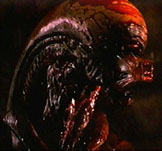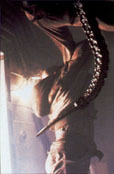

This is the final stage in the development of the standard xenomorph -- although there is great speculation of further development. In the previous stage, the creature was roughly one to two feet tall. In an extensive growth increase, it manages to become approximately 7 to 8 feet tall in a matter of hours. During this growth stage it is sometimes referred to as a 'calf', and sheds at least one layer of skin -- similar to a snake (in Alien, Brett finds a small piece of skin-like material about the size of the original burster on the ground.) In the usual case this increase in mass would take much longer. In Alien, it would've needed to feast on all the crew and metabolize their body mass before it even grew to be half the size of a man. We can also assume that is sheds skin multiple times in its rapid growth. In Alien3, while cleaning out a vent shaft, one of the prisoners discovers something similar to Brett's finding shortly before getting his skull punctured. One noticeable difference in this instance in the fact that there were burn marks on some of the structure, Clemens takes a closer examination of this. The shedding of skin while increasing body mass might also result in secretion or loss of blood (acid). In this same scene, the alien doesn't appear to be fully mature, but definitely larger then the original burster-- proving that it doesn't instantaneously grow to full size. Whether the alien needs any food at all for growth is has not been fully determined. In Alien it obviously has no food source between birth out of Kane, and the death of Brett, where it has grown to full size.
The xenomorph's skin appears a chitin like shell similar to bugs. It is hard, dark (black/green), and acts as an outer shell (exo-skeleton). It is by no means impervious (easily shattered by bullets), but has a higher tolerance to fire. As indicated in Aliens the alien creature does not "show up" on infra-red scanners which would indicate that it does not emit heat. It contains acid for blood, which tends to spray when hit by bullets.

During it's growth its cranium becomes elongated, and at full development the xenomorph has a banana-shaped skull. In Alien3 this is no surprise because the burster is very similar to the final product, while in Alien and Aliens, it is less apparent-- the burster has a more snake-like body instead of a separate head. Another noticeable difference is that the aliens in Aliens had only 3 fingers as opposed to the 6 fingered creature in Alien This may be due to either the host, the egg/facehugger, who laid the egg, or the environment. It may also be due to the "type" of alien. (ie: a soldier instead of a worker) Although they have this large cranium, xenomorphs have rudimentary thinking skills. When Ripley is in the hive, several aliens filter in to attack her; Ripley threatens to flame the eggs and the queen waves them off. In Alien3 it acted to protect Ripley (since she was carrying the queen embryo) when the doctor was go ing to give her an injection and when Dillon grabbed her (near the end). The aliens in Aliens cut the power to the complex (unless this was just an "accident"). However they also managed to "through" themselves at the sentry guns -- losing many of their kind in hope of obtaining a handful of hosts. The large skull may also serve the purpose of pressurization, hold some vital fluid, or to maintain balance.
There appears to be no eyes or other distinguishable optical sensors and may use sonar or something similar to bats to determine surroundings. In Aliens Newt mentions that they mostly come out at night, this would imply that sight is not their primary sense. In Alien3 we see the view of the xenomorph as it chases after the prisoners. This view may be some sort of eyesight, or what is rendered in its mind from ultrasound including quadraphonic hearing and hyper-accurate ranging capability and other sensors.
Another attribute seen in the adult is the long dark spines sticking out of the back. These could be functionally similar to the plates on the back of a Stegosaurus; they make it difficult to land a damaging blow on the alien from a sneak-attack from behind. The spines could also be some form of reservoir for acid (similar to the humps on a camel).

The adult alien possesses a "double jaw", or 2 mouths -- one inside of the other. Once again the only known burster possessing this is the one seen in Alien3 while the others contained only a single jaw (easily distuingshed in Alien). The outer jaw is hinged primarily by tendon-like apertures and is supported similar to that of a snake. The second jaw (also referred to as the "tongue") can extend out to about a foot long reach. It has a very strong driving force (enough to easily puncture skulls), almost like a pneumatic power. (possible another use of the elongated cranium).

The xenomorph's tail has grown proportionally and is not only used for balance, but attack. It has a barbed "stinger" at the end of it, which in the novel for Aliens is what punctures Gorman, paralyzing him. We see the queen alien puncture Bishop (near the end of alien), and use its tail when fighting Ripley. In Alien3, when Ripley is trying to get the creature into the mold, it also uses its tail in attack. The tail itself has a long row of connected spines along the top of it.
The adult is also extremely agile. In Aliens it can be seen leaping from wall to wall and crawling on the ceiling. During Alien3 the xenomorph is running all over the place -- sideways, upside down, hopping from ledges. The creature also has amazing mechanical-like strength. At the beginning of the first battle in Aliens an alien grips Dietrich from the shoulders and lifts her straight up. They manage to pound through metal doors and walls, becoming virtually unstoppable.
The speculation of further development lies upon alien interaction of a society. When there is no queen present (or eggs) many different things could happen. A present xenomorph could morph into a queen through a cocoon like transformation. Or, a standard alien could have the capability of laying one egg in order to produce a queen. Another way to produce the egg (according to Giger's original idea) would be by the xenomorph infecting a host. With no other aliens present, the dog-burster and the one in Alien were not queens?? This could be due to ensure there are no rival queens in the area. A xenomorph would develop, check the place out, and then communicate with the egg/facehugger -- to develop into queen producing stuff. This would also substantiate the reasoning for the prolonged embryo incubation inside of Ripley. The embryo - being a queen - would take longer to develop to ensure enough distance from the original hive.
The hive society itself is rather complex and consists of a variety of alien versions. The reasoning for the "ribbed" craniums in Aliens could be that they are warrior xenomorphs. These aliens would be in charge of protecting the colony and attacking intruders. In this "theoretical" society (similar to bees or ants as described by Hudson and Vasquez's conversation in Aliens) there would also be the drone aliens. Their duty would be to tend to the queen/eggs, construct the hive and cocoon possible hosts. With no signs of physical communication seen by the aliens, we can assume some type of telepathic connection between the creatures, with the queen running the whole show. Communication could also be the answer to the "ribbed" vs. "smooth" craniums. Lone adults have uniform smooth reflective heads, while adults functioning in a nest have distinct anterior and posterior head sections; the posterior region being covered in a ribbed pattern with a pair of pits on either side of the head. This morphology in social organisms may be used in sonic and chemical communication. That this ribbed pattern is visible in the neck regions of the lone adult may indicate that the smooth reflective surface of the heads serves as a canopy covering more complex structures.